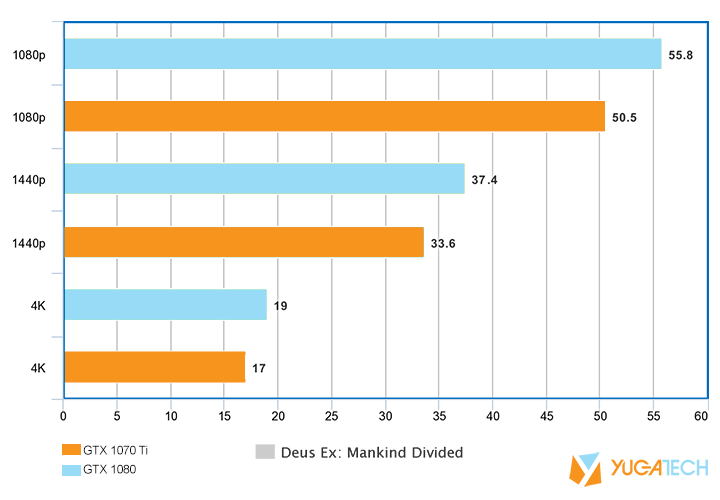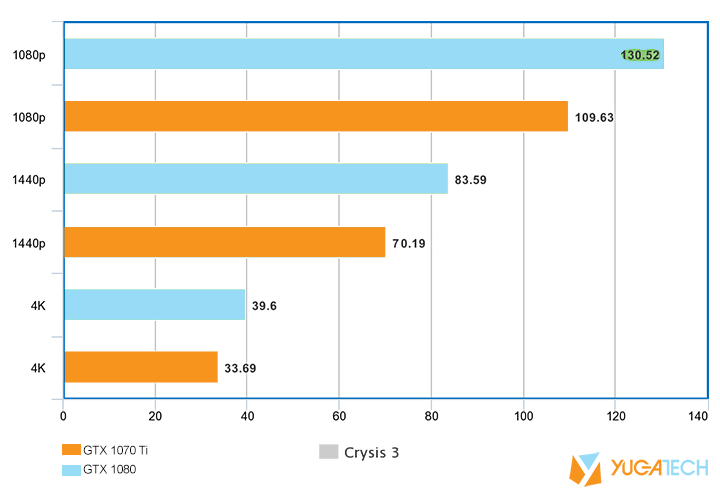If you’ve seen our review of the GTX 1070 Ti, then you heard us say that it offers similar performance to the GTX 1080. Now, let us show you what I mean by that.

For this, we’re gonna compare the performance of the GTX 1080 to that of the 1070 Ti. The test setup we used for both cards is the same one mentioned in our review of the 1070 Ti. For reference, here it is.
Disclosure: Title has been changed to better reflect the article. The original title was “How NVIDIA killed the GTX 1080”.
| CPU | Intel Core i7-6700K |
| Motherboard | Gigabyte Z170M-D3H |
| RAM | 2x8GB Corsair Vengeance LPX DDR4 @ 2666MHz |
| Storage | 250GB Samsung 850 Evo + 1TB WD Blue |
| PSU | Corsair RM650i |
| Case | Phanteks Eclipse P400 Tempered Glass Edition |
We’re also throwing in the GTX 1070 for some benchmarks since we have access to them. We are using the results from our review of the Lenovo Y720 Cube Gaming PC, which used a Founder’s Edition GTX 1070, and a CPU and RAM configuration similar enough to our test setup, such that net performance wouldn’t be significantly throttled. It packs an Intel Core i7-7700HQ and 16GB of DDR4 RAM.
Now that our setups have been disclosed, let’s begin with the synthetic benchmarks.
Note: Synthetic benchmarks are run at the highest settings at 1080p. The graphics cards were not overclocked.





It’s so close. The scores of the GTX 1070 Ti sit almost exactly in between those of the GTX 1070 and 1080, but the gap between those two cards was already pretty good in terms of placement within the stack, as well as pricing. Judging from these numbers, getting the GTX 1070 Ti to match the 1080 is only a matter of basic overclocking. Let’s move on to everyone’s favorite, gaming benchmarks.



At 1080p, the performance jump is fairly significant. Especially if you’re aiming for 144Hz or higher refresh-rates, then the 15-20fps jump is worth it. That isn’t to say that the 1070 Ti can’t achieve those numbers by bumping up the clock speeds. Also, consider that we ran these games at the highest possible graphics settings, so settling for High instead of Ultra will still give you a nice looking game, but exponentially increase your frame rates.
At 1440p and 4K however, you start to see diminishing returns. The performance increase is now generally only <15fps for 1440p, and <10 for 4K. We know that this will vary from game to game, and you can actually see that in the results. However, there is definitely a trend here.

This is actually great for us, the consumers. We are now in a better position than ever when it comes to high-tier graphics cards. A Founder’s Edition GTX 1070 Ti is priced at $449PHP 26,350INR 38,053EUR 428CNY 3,268 (~Php22,600USD 385INR 32,648EUR 367CNY 2,805 when converted), which is $100PHP 5,869INR 8,475EUR 95CNY 728 cheaper than a Founder’s Edition GTX 1080. The price difference for custom cards should be the same. Is the slight performance bump worth that extra $100PHP 5,869INR 8,475EUR 95CNY 728? I think not. The 1070 Ti arguably has the better value.
From a macro perspective, we can’t help but ask. Why was there a need to compete at this price point? Was it worth cannibalizing the GTX 1080?
The biggest reason on peoples’ minds, is that this price point was previously only occupied by AMD’s Vega 56. This is also the most logical business move for NVIDIA, as AMD is their biggest competitor in the GPU space. You could, however, argue that NVIDIA isn’t at a loss at all, since the GTX 1080 has already been out for a year and a half, and has already sold well.
The “Ti” in NVIDIA’s graphics cards is supposedly short for “Titanium”, which is supposed to signify improved performance and power efficiency. We don’t feel this as much with the GTX 1070 Ti. It’s less of a GTX 1070 Ti, and more of a GTX 1080 Lite. Is the “Ti” losing its meaning? Has it become just a designation for filler cards?

ASUS ROG Strix GeForce GTX 1070 Ti
We sincerely hope not. With all this, there is nothing more we can do. Board partners like ASUS, MSI, Gigabyte, Zotac, and others already have their custom cards out. If you’re in the market for a new graphics card, now you know that the 1070 Ti arguably has a better value than the 1080.
What do you think? Be sure to leave a comment down below and share your thoughts.

YugaTech.com is the largest and longest-running technology site in the Philippines. Originally established in October 2002, the site was transformed into a full-fledged technology platform in 2005.
How to transfer, withdraw money from PayPal to GCash
Prices of Starlink satellite in the Philippines
Install Google GBox to Huawei smartphones
Pag-IBIG MP2 online application
How to check PhilHealth contributions online
How to find your SIM card serial number
Globe, PLDT, Converge, Sky: Unli fiber internet plans compared
10 biggest games in the Google Play Store
LTO periodic medical exam for 10-year licenses
Netflix codes to unlock hidden TV shows, movies
Apple, Asus, Cherry Mobile, Huawei, LG, Nokia, Oppo, Samsung, Sony, Vivo, Xiaomi, Lenovo, Infinix Mobile, Pocophone, Honor, iPhone, OnePlus, Tecno, Realme, HTC, Gionee, Kata, IQ00, Redmi, Razer, CloudFone, Motorola, Panasonic, TCL, Wiko
Best Android smartphones between PHP 20,000 - 25,000
Smartphones under PHP 10,000 in the Philippines
Smartphones under PHP 12K Philippines
Best smartphones for kids under PHP 7,000
Smartphones under PHP 15,000 in the Philippines
Best Android smartphones between PHP 15,000 - 20,000
Smartphones under PHP 20,000 in the Philippines
Most affordable 5G phones in the Philippines under PHP 20K
5G smartphones in the Philippines under PHP 16K
Smartphone pricelist Philippines 2024
Smartphone pricelist Philippines 2023
Smartphone pricelist Philippines 2022
Smartphone pricelist Philippines 2021
Smartphone pricelist Philippines 2020
ZZZ says:
1070 Ti is the same price as 1080 everywhere I’ve checked with the normal 1070 being 21k-22k. With that pricing 1080 is the better buy imo.
Paul says:
So this claim that 1070 Ti kills the 1080… is it based on US suggested retail pricing? Because local PH prices for those cards are quite different.
For example, using PCHub’s pricing for 1070 Ti and 1080. Here’s a comparison of the average prices of those cards as of today Dec. 3:
1070 Ti (based on 6 sku) – 29,340 Php
1080 (based on 5 sku) – 29,166 Php
As you can see, the average selling price for 1080 is actually _lower_ than the 1070 Ti. Maybe a few months from now the local PH prices would adjust to reflect US SRP, but right now like ZZZ said the 1080 is better.
Jay says:
Hah, mukhang walang alam sa PH PC community yung author at mema-sulat lang. Unang una sa lahat, wala namang FE 1070Ti’s dito at kung meron man napaka rare nun. Panay base kase sa US pricing. Plus you know, I can just overclock the 1080 to leave the 1070Ti on the dust.
SilverInfinity says:
First off, I think your memory is way too short – the “Ti” branding has been used for non-flagship tiers before – 560 Ti, 660 Ti, and they have naturally always filled the gap between normal tiers.
Secondly, 1440p and 4K have always been diminishing returns for each generation, especially when AAA games are involved – the gap between products shrinks significantly than 1080p, nothing new there.
In fact, for 4K, the 1080Ti is the biggest performance gulf in recent memory VS the next lower tier.